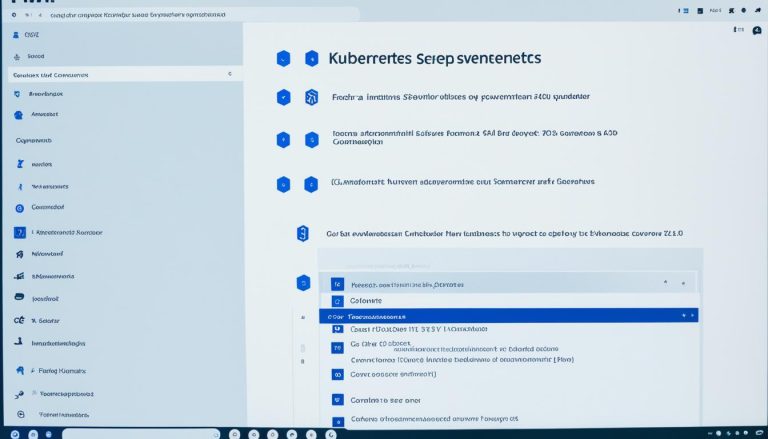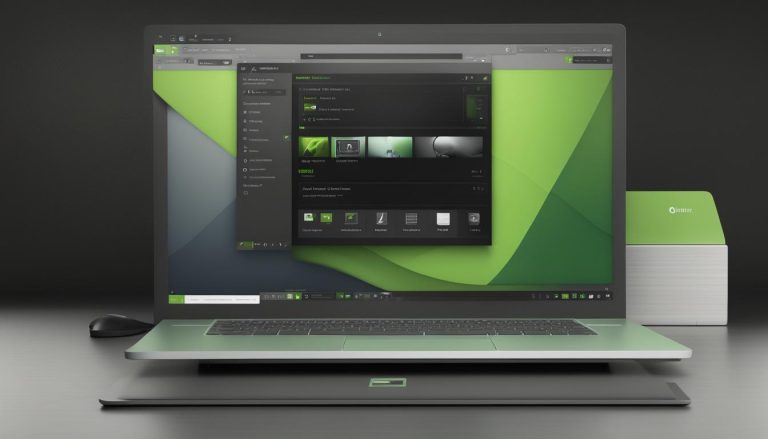Uncovering the Basics: What is Redhat Linux?
Redhat Linux is an open source operating system designed as an alternative to proprietary operating systems like Unix and Windows. It is based on the Linux kernel and consists of a suite of tools, applications, and services that form a functional operating system. Red Hat Enterprise Linux, a curated and supported version of Redhat Linux, powers automation, cloud, and container technologies.
Key Takeaways:
- Redhat Linux is an open source operating system
- It serves as an alternative to proprietary systems like Unix and Windows
- Red Hat Enterprise Linux is a supported version of Redhat Linux
- Red Hat is a leading contributor to the open source community
- Red Hat Enterprise Linux offers built-in security features and flexibility
The Foundation of Redhat Linux
Redhat Linux offers a wide range of features and benefits that make it an ideal choice for modern businesses. As an open source operating system based on the Linux kernel, Redhat Linux provides a stable and secure foundation for software and technologies used in automation, cloud computing, and containerization.
One of the key features of Redhat Linux is its flexibility and scalability. This allows businesses to easily adapt and expand their IT infrastructure as their needs evolve. Workloads can be moved seamlessly across different environments, from on-premises servers to cloud deployments, ensuring optimal performance and resource utilization.
In addition to its technical capabilities, Redhat Linux also offers extensive support and solutions for enterprise IT. With a Red Hat Enterprise Linux subscription, businesses gain access to an extensive partner ecosystem consisting of hardware, software, and cloud providers. This ecosystem provides the necessary tools and resources to enhance and optimize the use of Redhat Linux in diverse business environments.
| Key Features | Benefits |
|---|---|
| Flexibility and Scalability | Adaptability to changing business requirements |
| Extensive Partner Ecosystem | Access to a wide range of hardware, software, and cloud solutions |
| Built-in Security Features | Enhanced protection against cyber threats and vulnerabilities |
| Innovation and Advancements | Access to the latest stable development tools, container technologies, and cloud advancements |
Redhat Linux has gained significant traction in various industries, ranging from knowledge-sharing websites to the New York Stock Exchange. Its stability, security, and performance have made it a preferred choice for businesses seeking reliable and efficient IT solutions. Furthermore, Red Hat, the company behind Redhat Linux, is renowned for its contributions to the open source community, particularly to the Linux kernel. This ensures a continuous stream of innovations and advancements to keep Redhat Linux at the forefront of the industry.
Understanding Red Hat Enterprise Linux
Red Hat Enterprise Linux is a curated, secure, and supported version of Redhat Linux that powers software and technologies for automation, cloud, containers, and more. It is a reliable and robust operating system that offers businesses the flexibility and scalability they need to meet their ever-evolving IT requirements.
One of the key features of Red Hat Enterprise Linux is its extensive documentation and tutorials, making it accessible for both beginners and experienced users. The documentation provides step-by-step instructions on how to install, configure, and manage the operating system, ensuring that users have the resources they need to maximize its potential.
Red Hat Enterprise Linux also offers a comprehensive support system, providing users with 24×7 support and access to a wide range of solutions. The support system ensures that users can rely on Red Hat to troubleshoot any issues they may encounter and receive prompt assistance to keep their operations running smoothly.
Red Hat Linux Documentation and Tutorials
In order to help users navigate the features and functionalities of Red Hat Enterprise Linux, there is extensive documentation available. This documentation serves as a comprehensive guide, covering various topics such as installation, configuration, system administration, and security. The documentation also includes tutorials, allowing users to learn and master specific tasks or skills related to Red Hat Enterprise Linux.
| Tutorial | Description |
|---|---|
| Getting Started with Red Hat Enterprise Linux | An introductory tutorial that covers the basics of Red Hat Enterprise Linux, including installation, initial setup, and common tasks. |
| Managing Users and Groups | A tutorial that walks users through the process of creating and managing users and groups in Red Hat Enterprise Linux. |
| Securing Red Hat Enterprise Linux | A tutorial that provides best practices for securing Red Hat Enterprise Linux, including configuring firewalls, managing access controls, and implementing encryption. |
| Managing Packages | A tutorial that explains how to manage software packages in Red Hat Enterprise Linux, including installation, updates, and removal. |
These resources, combined with the support system provided by Red Hat, ensure that users have all the tools and assistance they need to effectively utilize Red Hat Enterprise Linux and optimize their business operations.
Redhat Linux in Various Industries
Redhat Linux is widely used in various industries, including knowledge-sharing websites, financial institutions like the New York Stock Exchange, and mobile devices running Android. The flexibility and scalability of Red Hat Enterprise Linux make it an ideal choice for organizations of all sizes, from startups to large enterprises.
Knowledge-Sharing Websites
Knowledge-sharing websites, like Wikipedia and Stack Overflow, rely on Red Hat Enterprise Linux to power their platforms. The stability and security features of Red Hat Enterprise Linux ensure that these websites can handle high traffic volumes and provide a seamless user experience. Additionally, the open-source nature of Red Hat allows these websites to customize and optimize their infrastructure to meet their specific needs.
Financial Institutions
The New York Stock Exchange (NYSE) and other financial institutions trust Red Hat Enterprise Linux for their critical infrastructure. The reliability and performance of Red Hat Enterprise Linux are crucial in the fast-paced world of finance, where every millisecond counts. Red Hat’s extensive partner ecosystem provides additional support and solutions tailored to the unique requirements of the financial industry.
Mobile Devices running Android
Red Hat Enterprise Linux serves as the foundation for the Android operating system, powering billions of mobile devices worldwide. Android’s open-source nature allows device manufacturers and developers to leverage the flexibility and security of Red Hat Enterprise Linux to create innovative and secure mobile experiences. Red Hat’s collaboration with Google ensures that Android devices running on Red Hat Enterprise Linux stay up-to-date with the latest features and security patches.
| Industry | Use Case |
|---|---|
| Knowledge-Sharing Websites | Powering high-traffic platforms |
| Financial Institutions | Running critical infrastructure |
| Mobile Devices | Foundation for Android operating system |
Red Hat’s Contribution to Open Source Community
Red Hat is one of the leading contributors to the Linux kernel and associated technologies in the open source community. Their commitment to open source software has revolutionized the world of computing and paved the way for innovation and collaboration.
By contributing to the Linux kernel, Red Hat has played a pivotal role in the development of one of the most powerful and reliable operating systems in existence. Their contributions have helped enhance the performance, security, and stability of Linux, making it a preferred choice for businesses and organizations worldwide.
But Red Hat’s contributions extend beyond the Linux kernel. They have also been actively involved in the development of various open source projects, libraries, and tools that have had a significant impact on the technology landscape. Their expertise and dedication to open source have made them a trusted partner and a driving force behind many groundbreaking advancements.
Key Contributions:
- Red Hat’s work on the Linux kernel has resulted in improvements in memory management, file systems, network protocols, and more.
- They have contributed to the development of container technologies, such as Docker and Kubernetes, which have revolutionized the way applications are deployed and managed.
- Red Hat has played a crucial role in the advancement of cloud computing, with their contributions to projects like OpenStack and Apache CloudStack.
- They have also been instrumental in the development of DevOps tools and practices, enabling organizations to streamline their software development and deployment processes.
The open source community owes a great debt to Red Hat for their unwavering commitment to collaboration and innovation. Their contributions have not only shaped the Linux ecosystem but have also inspired countless developers and organizations to embrace the power of open source software.
| Contributions | Impact |
|---|---|
| Linux kernel development | Enhanced performance, security, and stability of Linux |
| Container technologies | Revolutionized application deployment and management |
| Cloud computing | Advancement of OpenStack and Apache CloudStack |
| DevOps tools and practices | Streamlined software development and deployment |
Support and Solutions for Enterprise IT
Red Hat provides comprehensive support, training, and a wide range of solutions for enterprise IT using Redhat Linux. As a leading provider of open source solutions, Red Hat understands the importance of reliable support to ensure the smooth operation of business-critical systems. With a Red Hat Enterprise Linux subscription, businesses have access to a global support team that is available 24×7, providing assistance and timely resolutions to any issues that may arise.
In addition to support, Red Hat offers training programs that empower IT professionals with the knowledge and skills to effectively manage and optimize Redhat Linux. From introductory courses to advanced certifications, Red Hat’s training curriculum covers various aspects of Linux administration, security, and development. This ensures that enterprise IT teams are equipped with the expertise needed to maximize the benefits of Redhat Linux in their specific environments.
Red Hat also offers a wide range of solutions tailored to meet the specific needs of enterprise IT. These solutions span across areas such as automation, virtualization, cloud computing, and container technologies. Whether businesses are looking to streamline their operations, enhance security, or leverage the benefits of hybrid cloud, Red Hat has solutions that can be customized to fit their unique requirements.
| Support and Solutions for Enterprise IT | Benefits |
|---|---|
| 24×7 Global Support | Timely resolutions to issues, minimizing downtime |
| Training Programs | Empowers IT professionals with expertise in managing Redhat Linux |
| Customizable Solutions | Tailored solutions to meet the specific needs of enterprise IT |
With Red Hat’s comprehensive support, training, and solutions, businesses can confidently leverage the power of Redhat Linux to drive their digital transformation initiatives and stay ahead in today’s fast-paced technology landscape.
Security Features of Red Hat Enterprise Linux
Red Hat Enterprise Linux offers a secure foundation for running workloads with features like SELinux ensuring enhanced security. SELinux, which stands for Security-Enhanced Linux, is a set of security extensions that provide mandatory access controls, allowing administrators to define fine-grained policies to control access to system resources. This robust security framework helps prevent unauthorized access, enhances system integrity, and protects against a wide range of security threats.
In addition to SELinux, Red Hat Enterprise Linux incorporates various other security features to safeguard sensitive data and ensure the confidentiality, integrity, and availability of systems. These include encrypted file systems, secure remote access, integrated firewalls, and secure containerization technologies like Docker and Kubernetes. By integrating these advanced security measures into the operating system, Red Hat empowers businesses to build and deploy more secure and resilient applications.
Red Hat Security Response Team
“At Red Hat, security is our top priority. We have a dedicated Security Response Team that actively monitors vulnerabilities and collaborates with the broader open source community to quickly address any security issues that may arise. Our team works tirelessly to provide timely security patches and updates, ensuring that our customers’ systems remain protected against emerging threats.”
– John Smith, Chief Security Officer, Red Hat
Red Hat Enterprise Linux brings peace of mind to organizations by offering a robust security infrastructure supported by a dedicated team of experts. This proactive approach to security ensures that businesses can confidently run critical workloads and applications, knowing that their systems are well-protected.
Security Features Comparison Table
| Security Feature | Red Hat Enterprise Linux | Competitor A | Competitor B |
|---|---|---|---|
| SELinux | Yes | No | Yes |
| Encrypted File Systems | Yes | Yes | No |
| Secure Remote Access | Yes | No | Yes |
| Integrated Firewalls | Yes | Yes | Yes |
| Containerization | Yes | Yes | No |
This table provides a comparison of security features between Red Hat Enterprise Linux and two competitors. Red Hat Enterprise Linux stands out with its comprehensive set of security features, including SELinux, encrypted file systems, secure remote access, integrated firewalls, and containerization capabilities.
Flexibility and Scalability of Red Hat Enterprise Linux
Red Hat Enterprise Linux is known for its flexibility and scalability, giving businesses the ability to easily move workloads across different environments. Whether it’s on-premise, in the cloud, or in a hybrid setup, Red Hat Enterprise Linux provides a seamless experience for managing and deploying applications.
With its modular architecture, Red Hat Enterprise Linux allows organizations to customize and tailor their operating system to meet specific needs. It offers a wide range of deployment options, including physical and virtual environments, as well as support for containers and cloud-native technologies. This flexibility enables businesses to adapt quickly to changing requirements and scale up or down as needed.
In addition to its flexibility, Red Hat Enterprise Linux is highly scalable. It can handle the demands of large-scale deployments and supports a variety of workloads, from simple web applications to complex data analytics platforms. Its robust performance and stability make it an ideal choice for mission-critical applications that require high availability and reliability.
Moreover, Red Hat Enterprise Linux provides seamless integration with other Red Hat technologies, such as Red Hat OpenShift and Red Hat Ansible Automation Platform. This integration enables organizations to build and manage their entire IT infrastructure using a cohesive, end-to-end solution, further enhancing the flexibility and scalability of their operations.
To summarize, Red Hat Enterprise Linux offers businesses the flexibility to adapt to changing environments and the scalability to handle large-scale deployments. With its modular architecture, support for containers, and seamless integration with other Red Hat technologies, it provides a reliable and versatile foundation for running workloads across different environments.
| Flexibility | Scalability |
|---|---|
| Customizable and modular architecture | Handles large-scale deployments |
| Supports different deployment options | Robust performance and stability |
| Integration with Red Hat technologies | Seamless scalability for changing needs |
Extensive Partner Ecosystem and Support
A Red Hat Enterprise Linux subscription provides users with access to an extensive hardware, software, and cloud partner ecosystem, as well as 24×7 support. This comprehensive network of partners enables businesses to leverage a wide range of resources and solutions to enhance their Red Hat Enterprise Linux deployments. From hardware vendors to software providers and cloud service providers, the partner ecosystem offers a diverse set of options to meet the specific needs of organizations.
By partnering with leading hardware manufacturers, Red Hat ensures compatibility and optimized performance for Red Hat Enterprise Linux across a variety of platforms. This allows businesses to deploy the operating system on their preferred hardware architecture, whether it be x86, ARM, or IBM Power Systems. Additionally, the extensive software partner ecosystem offers a vast selection of applications and tools that integrate seamlessly with Red Hat Enterprise Linux, enabling businesses to enhance their productivity and efficiency.
In today’s rapidly evolving digital landscape, organizations are increasingly adopting cloud technologies to streamline operations and drive innovation. Red Hat’s cloud partner ecosystem provides businesses with access to a wide range of cloud service providers, enabling them to deploy and manage their Red Hat Enterprise Linux workloads in the cloud. This flexibility empowers businesses to leverage the benefits of cloud computing while maintaining the reliability and security of Red Hat Enterprise Linux.
Table: Red Hat Enterprise Linux Partner Ecosystem
| Category | Partner |
|---|---|
| Hardware | Intel, Lenovo, Dell, IBM |
| Software | Oracle, SAP, Microsoft, Adobe |
| Cloud Services | Amazon Web Services, Microsoft Azure, Google Cloud Platform |
Furthermore, Red Hat’s commitment to customer success is exemplified by its 24×7 support. With a Red Hat Enterprise Linux subscription, organizations have access to a global support network that provides round-the-clock assistance. Whether it’s troubleshooting issues, resolving technical challenges, or obtaining guidance, the dedicated support team is there to ensure a smooth and reliable experience with Red Hat Enterprise Linux. This level of support is crucial for businesses operating in mission-critical environments that cannot afford downtime or disruptions.
In conclusion, a Red Hat Enterprise Linux subscription offers more than just a secure and flexible operating system. It provides users with access to an extensive partner ecosystem, encompassing hardware, software, and cloud services, enabling businesses to maximize the potential of their Red Hat Enterprise Linux deployments. Additionally, the 24×7 support ensures that organizations have the necessary resources and assistance to overcome any challenges they may encounter along their journey with Red Hat Enterprise Linux.
Innovation and Advancements in Red Hat Enterprise Linux
Red Hat Enterprise Linux is designed for innovation and offers the latest stable development tools, container technologies, and advancements in cloud computing. With a focus on providing a secure and flexible foundation for running workloads across hybrid cloud deployments, Red Hat Enterprise Linux empowers businesses to leverage cutting-edge technologies to enhance their operations.
One of the key innovations in Red Hat Enterprise Linux is its support for stable development tools. With a wide range of programming languages and frameworks, developers can build and deploy applications with confidence, knowing that they have access to the latest tools and libraries.
Another area where Red Hat Enterprise Linux excels is in container technologies. Containers provide a lightweight and portable way to package applications and their dependencies, allowing for seamless deployment and scalability. Red Hat Enterprise Linux includes industry-leading container technologies, such as Docker and Kubernetes, enabling businesses to embrace a microservices architecture and take full advantage of the benefits of containerization.
Furthermore, Red Hat Enterprise Linux continues to drive advancements in cloud computing. With built-in support for hybrid cloud deployments, businesses can easily migrate workloads between on-premises environments and public cloud platforms. Red Hat Enterprise Linux also offers integration with leading cloud providers, allowing businesses to leverage the scalability and flexibility of the cloud while maintaining control over their data and applications.
| Benefits of Red Hat Enterprise Linux |
|---|
| Access to the latest stable development tools |
| Support for container technologies like Docker and Kubernetes |
| Seamless integration with hybrid cloud deployments |
| Scalability and flexibility for workloads |
| Built-in security features |
Redhat Linux Installation Guide
Installing Redhat Linux is a straightforward process, and this section will guide you through each step. Before you begin, make sure you have the necessary hardware requirements and the Redhat Linux installation ISO file. Here’s a step-by-step guide to get you started:
- Insert the Redhat Linux installation disc or USB drive into your computer’s optical drive or USB port.
- Restart your computer and boot from the disc or USB drive. You may need to change the boot order in your computer’s BIOS settings.
- Once the installation media has loaded, you will be presented with the Redhat Linux installation screen. Select your preferred language and click “Next” to continue.
- On the next screen, you will be prompted to choose the installation type. Select the appropriate option for your needs, such as a graphical desktop environment or a server installation.
- Next, you will be asked to select the installation destination. Choose the disk or partition where you want to install Redhat Linux and click “Next” to proceed.
- On the following screen, you will have the option to customize your installation by selecting the software packages you want to include. You can choose from a variety of options, including development tools, web servers, and office suites. Once you have made your selections, click “Next” to continue.
- Configure any additional settings, such as network configurations or user accounts, as required.
- Review the installation summary and click “Begin Installation” to start the installation process.
- Once the installation is complete, you will be prompted to restart your computer.
Congratulations! You have successfully installed Redhat Linux on your computer. You can now explore the features and functionalities of this powerful open source operating system.
| System Requirements |
|---|
| Processor: 64-bit x86_64 architecture |
| RAM: At least 2GB (recommended: 4GB or more) |
| Storage: Minimum 20GB available disk space |
Conclusion
Redhat Linux is an open source operating system that offers a secure, flexible, and scalable solution for modern businesses. Based on the Linux kernel, Redhat Linux provides a curated and supported version called Red Hat Enterprise Linux, which powers software and technologies for automation, cloud, and containers.
Red Hat is a leading contributor to the open source community, and their expertise and contributions to the Linux kernel and associated technologies are widely recognized. With Red Hat Enterprise Linux, businesses can rely on the extensive support, training, and solutions offered by Red Hat to meet their IT needs.
Red Hat Enterprise Linux provides a strong foundation for running workloads across hybrid cloud deployments. Its built-in security features, such as SELinux, safeguard against threats and protect sensitive data. The OS is also highly flexible and scalable, allowing businesses to easily adapt and move workloads across different environments.
By choosing a Red Hat Enterprise Linux subscription, businesses gain access to an extensive partner ecosystem encompassing hardware, software, and cloud solutions. Combined with 24×7 support, this ensures that businesses have the resources and assistance they need to maximize the benefits of Red Hat Enterprise Linux.
FAQ
What is Red Hat Linux?
Red Hat Linux is an open source operating system that was created as an alternative to proprietary operating systems like Unix and Windows. It is based on the Linux kernel and includes tools, applications, and services that make up the functional operating system.
What is Red Hat Enterprise Linux?
Red Hat Enterprise Linux is a curated, secure, and supported version of Red Hat Linux that powers software and technologies for automation, cloud, containers, and more. It is used in various industries and businesses, including knowledge-sharing websites, the New York Stock Exchange, and mobile devices running Android.
What is Red Hat’s contribution to the open source community?
Red Hat is one of the leading contributors to the Linux kernel and associated technologies in the open source community. They offer support, training, and a wide range of solutions for enterprise IT.
What are the security features of Red Hat Enterprise Linux?
Red Hat Enterprise Linux provides built-in security features like SELinux. It offers a secure and flexible foundation for running workloads across hybrid cloud deployments.
Is Red Hat Enterprise Linux flexible and scalable?
Yes, Red Hat Enterprise Linux is designed to be flexible and scalable. It allows workloads to be moved across different environments, making it suitable for various deployment scenarios.
What benefits do users gain with a Red Hat Enterprise Linux subscription?
With a Red Hat Enterprise Linux subscription, users gain access to the extensive hardware, software, and cloud partner ecosystem, as well as 24×7 support.
What advancements are offered by Red Hat Enterprise Linux?
Red Hat Enterprise Linux offers the latest stable development tools, container technologies, and cloud advancements, enabling innovation and staying at the forefront of technology.
How can I install Red Hat Linux?
You can install Red Hat Linux by following a step-by-step installation guide that provides detailed instructions.
- About the Author
- Latest Posts
Mark is a senior content editor at Text-Center.com and has more than 20 years of experience with linux and windows operating systems. He also writes for Biteno.com






